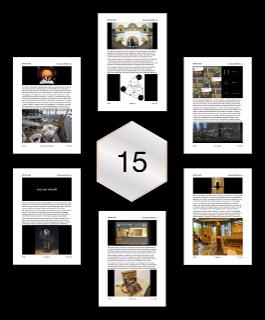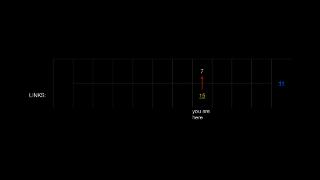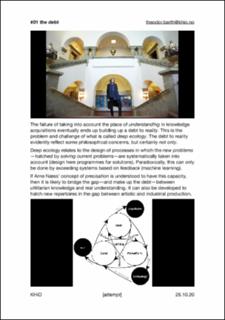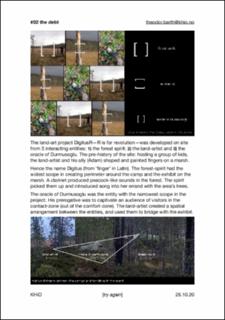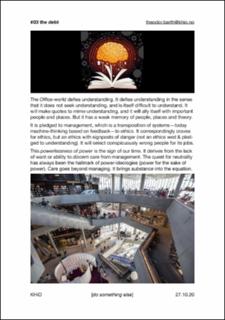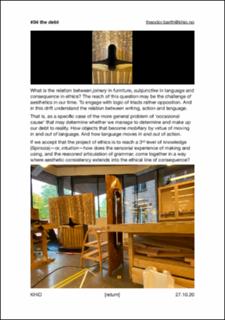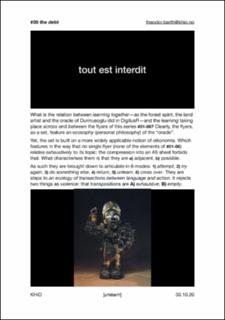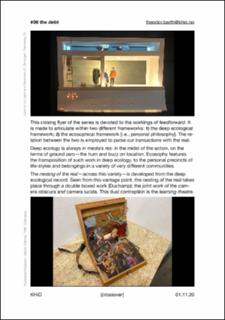the debt #01-06
| dc.contributor.author | Barth, Theodor | |
| dc.contributor.editor | Barth, Theodor | |
| dc.coverage.spatial | Norway, Oslo | en_US |
| dc.date.accessioned | 2020-11-02T06:47:15Z | |
| dc.date.available | 2020-11-02T06:47:15Z | |
| dc.date.issued | 2020-11-03 | |
| dc.identifier.uri | https://hdl.handle.net/11250/2685957 | |
| dc.description | [WALKABOUT: click file NAVIGATION EXHIBIT] The HEX form as criticality in structural power. The form of data-sets and empowerment. 1 HEX = #01) attempt; #02) try again; #03) do something else; #04) return; #05) unlearn; #06) cross over, | en_US |
| dc.description.abstract | The debt #01-06 is a flyer series written as a modular diary—linked to events, activities and topics that have come my way in the expanse of 2 weeks. During these two weeks a chief concern has been the how the structural power in society, can become indebted to the realities it aims at managing. One of the causes could be that the professionalisation of management causes a blind eye to the fact that managerial processes—even as they operate in the expanded field reaching all the way to self-management—are bureaucratic: that is, operates according to a technological reduction of power as engineered work-processes. When dressing up a critique, as is done in flyer #01, one is invariably asked to come up with alternatives. Which is why the experiences from a land-art project #02 is included into the stack. Based on this experience, a follow-up on care—as moving a critical step beyond managing—is done #03 (based on two named examples of teaching at KHiO). In #04 a new ground-zero, or beginning, is established, to initiate a new work-phase separating and connecting #01-03 to #04-06. The idea is similar to traditional photography, where two work-phases—essentially camera lucida and camera obscura—connect according to some principles to be established here for the land-art project as a specific case #05, and the broader issues of precisation it entails #06 for the ‘learning theatre’ to come out as an alternative contraption to the bureaucratic one (drawing on Marcel Duchamp’s double-boxed works). | en_US |
| dc.language.iso | eng | en_US |
| dc.publisher | KHiO | en_US |
| dc.relation.haspart | Flyer set: #01-06 | en_US |
| dc.relation.haspart | 1 HEX | en_US |
| dc.rights | Attribution-NoDerivatives 4.0 Internasjonal | * |
| dc.rights.uri | http://creativecommons.org/licenses/by-nd/4.0/deed.no | * |
| dc.subject | phenomenology | en_US |
| dc.subject | land-art | en_US |
| dc.subject | semiotics | en_US |
| dc.subject | economics | en_US |
| dc.subject | deep ecology | en_US |
| dc.subject | ecosophy | en_US |
| dc.subject | personal philosophy | en_US |
| dc.subject | furniture | en_US |
| dc.subject | industrial art | en_US |
| dc.subject | photography | en_US |
| dc.subject | transposition | en_US |
| dc.subject | precisation | en_US |
| dc.subject | learning theatre | en_US |
| dc.subject | action theory | en_US |
| dc.title | the debt #01-06 | en_US |
| dc.type | Design | en_US |
| dc.rights.holder | Theodor Barth | en_US |
| dc.subject.nsi | visual anthropology | en_US |
| dc.subject.nsi | work life studies | en_US |
| dc.subject.nsi | data science | en_US |
| dc.subject.nsi | artistic research | en_US |
Tilhørende fil(er)
Denne innførselen finnes i følgende samling(er)
-
Barth, Theodor [102]
Kunstneriske resultater og prosjekter
